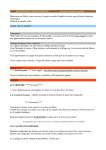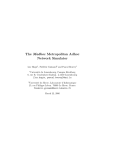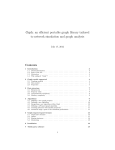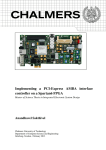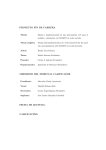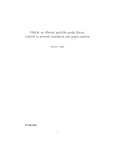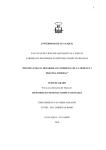Download DRMSim - Sophia Antipolis
Transcript
DRMSim: a network simulator for the
investigation of routing schemes
User manual
Luc Hogie1 , Issam Tahiri1 , Dimiti Papadimitriou2 , Frédéric Majorczyk3
1
Mascotte project, INRIA Sophia-Antipolis (FR)
2
3
LaBRi, University of Bordeaux (FR)
Alcatel Lucent-Bell, Antwerpen (BE)
February 1, 2010
Contents
1 Package overview
4
2 Installation
2.1 Prerequisite . . . . . . . . . . . . . . . . . . . . . . . . . . . . . .
2.2 Procedure . . . . . . . . . . . . . . . . . . . . . . . . . . . . . . .
2.3 Files installed . . . . . . . . . . . . . . . . . . . . . . . . . . . . .
4
4
5
5
3 DRMSim’s commands
6
4 Software architecture
4.1 Module dependencies . . . .
4.1.1 Mascsim . . . . . . .
4.1.2 Dipergrafs . . . . . .
4.1.3 Java4unix . . . . . .
4.1.4 Graphstream . . . .
4.2 Object-oriented model . . .
4.3 Measurement model . . . .
4.4 Graphical monitoring of the
.
.
.
.
.
.
.
.
.
.
.
.
.
.
.
.
.
.
.
.
.
.
.
.
.
.
.
.
.
.
.
.
.
.
.
.
.
.
.
.
.
.
.
.
.
.
.
.
.
.
.
.
.
.
.
.
.
.
.
.
.
.
.
.
.
.
.
.
.
.
.
.
.
.
.
.
.
.
.
.
.
.
.
.
.
.
.
.
8
8
8
9
9
9
9
9
12
5 Introduction to routing
5.1 Routing in the current Internet . . . . . . . . .
5.2 Classification of routing protocols . . . . . . . .
5.2.1 Distance-vector and link-state protocols
5.2.2 AS-level or router-level routing . . . . .
.
.
.
.
.
.
.
.
.
.
.
.
.
.
.
.
.
.
.
.
.
.
.
.
.
.
.
.
.
.
.
.
.
.
.
.
.
.
.
.
12
12
13
13
13
. . . . . . . . .
. . . . . . . . .
. . . . . . . . .
. . . . . . . . .
. . . . . . . . .
. . . . . . . . .
. . . . . . . . .
routing process
1
.
.
.
.
.
.
.
.
6 Simulation models
6.1 Network model . . . . . . . . . . . .
6.1.1 On memory consumption and
6.2 Routing protocols . . . . . . . . . . .
6.2.1 Standard set . . . . . . . . .
6.2.2 BGP . . . . . . . . . . . . . .
6.2.3 RIP . . . . . . . . . . . . . .
6.3 Metrics . . . . . . . . . . . . . . . .
6.4 Topology generators . . . . . . . . .
6.4.1 Standard set . . . . . . . . .
6.4.2 Randomized set . . . . . . . .
6.4.3 Tier 1/Tier 2/Tier T3 . . . .
6.4.4 Inet . . . . . . . . . . . . . .
6.4.5 Brite . . . . . . . . . . . . . .
6.4.6 GT-ITM . . . . . . . . . . . .
6.4.7 CAIDA . . . . . . . . . . . .
6.5 Dynamics . . . . . . . . . . . . . . .
6.6 Traffic model . . . . . . . . . . . . .
6.7 Time model . . . . . . . . . . . . . .
6.8 Granularity . . . . . . . . . . . . . .
. . . . . . . . . . . . . . . .
computational performance
. . . . . . . . . . . . . . . .
. . . . . . . . . . . . . . . .
. . . . . . . . . . . . . . . .
. . . . . . . . . . . . . . . .
. . . . . . . . . . . . . . . .
. . . . . . . . . . . . . . . .
. . . . . . . . . . . . . . . .
. . . . . . . . . . . . . . . .
. . . . . . . . . . . . . . . .
. . . . . . . . . . . . . . . .
. . . . . . . . . . . . . . . .
. . . . . . . . . . . . . . . .
. . . . . . . . . . . . . . . .
. . . . . . . . . . . . . . . .
. . . . . . . . . . . . . . . .
. . . . . . . . . . . . . . . .
. . . . . . . . . . . . . . . .
7 Frequently Asked Questions (FAQs)
7.1 What is the input of the simulator? . . . . . . . . . . . .
7.2 Is it possible to define my own topology? . . . . . . . . .
7.3 . . . deal with the output . . . . . . . . . . . . . . . . . .
7.4 How can I add a new metric . . . . . . . . . . . . . . . .
7.5 How can I generate a GLP graph . . . . . . . . . . . . .
7.6 How to implement a new routing protocol . . . . . . . .
7.7 Is there a way to import a new topology (CAIDA, Inet))
7.8 How to run DRMSim? . . . . . . . . . . . . . . . . . . .
7.8.1 One to one . . . . . . . . . . . . . . . . . . . . .
7.8.2 All to all . . . . . . . . . . . . . . . . . . . . . .
7.8.3 DoNothing . . . . . . . . . . . . . . . . . . . . .
7.9 . . . monitor a simulation process . . . . . . . . . . . . . .
.
.
.
.
.
.
.
.
.
.
.
.
.
.
.
.
.
.
.
.
.
.
.
.
.
.
.
.
.
.
.
.
.
.
.
.
.
.
.
.
.
.
.
.
.
.
.
.
.
.
.
.
.
.
.
.
.
.
.
.
13
14
14
14
14
15
19
19
20
21
21
21
22
22
22
23
23
23
23
23
23
23
24
24
24
24
25
25
25
25
25
25
25
8 Implementation notes
26
8.1 Code reuse . . . . . . . . . . . . . . . . . . . . . . . . . . . . . . 26
8.1.1 Madhoc . . . . . . . . . . . . . . . . . . . . . . . . . . . . 26
8.1.2 Dipergrafs . . . . . . . . . . . . . . . . . . . . . . . . . . . 26
8.1.3 GraphStream . . . . . . . . . . . . . . . . . . . . . . . . . 26
8.1.4 CoLibA . . . . . . . . . . . . . . . . . . . . . . . . . . . . 26
8.1.5 Ploticus . . . . . . . . . . . . . . . . . . . . . . . . . . . . 27
8.2 Invocation . . . . . . . . . . . . . . . . . . . . . . . . . . . . . . . 27
8.2.1 Drawing a network: alu-network-printer . . . . . . . . 27
8.2.2 Running a simulation: mascsim compute simulation . . 27
8.2.3 Running a simulation: alu-scan-available-topology-generators 27
2
8.3
8.4
Results . . . . . . . . . . . . . . . . . . . . . . . . . . . . . . . . .
Simulation campains . . . . . . . . . . . . . . . . . . . . . . . . .
3
27
27
This working paper describes DRMSim, a software simulator that aims at
the evaluation of routing protocols at a large scale. Indeed most simulator do
not allow the simulations of more than a few hundred nodes. DRMSim is an
attempt to simulate up to ten thousand nodes on typical workstations. Its
development happens in the context of a study focusing on dynamic compact
routing. A key target is to provide a software that is able to handle simulated
networks consisting of a mininum of ten thousands nodes. This requirement
imposes a careful analysis of the data structures that will be used in the network
model as well as on the granularity and time management of the simulation
model. This joint research project is conducted by Alcatel-Lucent Bell, Universit
de Bordeaux (LaBri) and INRIA labs at Sophia Antipolis (Mascotte project).
It is funded by Alcatel-Lucent Bell. The design/development philosophy of
DRMSim is make to compromise on the quality of the code written so that
extensibility and reusability are maximized.
1
Package overview
The official webpage for the DRMSim project is:
http://www-sop.inria.fr/mascotte/projets/DCR/
The software is the union of several projects, including Mascsim, a discreteevent simulation platform:
http://www-sop.inria.fr/members/Luc.Hogie/mascsim/
A graph library:
http://www-sop.inria.fr/members/Luc.Hogie/dipergrafs/
A bridge between Java and UNIX:
http://www-sop.inria.fr/members/Luc.Hogie/java4unix/
And a graph render library:
http://graphstream.sourceforge.net/
2
2.1
Installation
Prerequisite
In order to use DRMSim, you must have an UNIX operating system. Of course,
Linux is fine. The choice for the Java Virtual Machine is more tricky. More
4
UNIX computers around actually are Linux boxes. Linux comes with a Java
Virtual Machine: GCJ1 .
According to its official website, “GCJ is a portable, optimizing, ahead-oftime compiler for the Java Programming Language. It can compile Java source
code to Java bytecode (class files) or directly to native machine code, and Java
bytecode to native machine code”. According to most users, it does not work.
DRMSim proved unoperational when running atop GCJ. If DRMSim (or its
installation program) does not work on your machine, checking the JVM is the
first thing to do.
DRMSim turns out to work fine with both Sun’s official JVM and OpenJDK.
2
DRMSim was successfully tested on the following platforms, using Sun’s
JDK version 1.6 or OpenJDK:
• Ubuntu 9.04;
• Fedora 10;
• CentOS 5.4;
We still have not tested it under Mac OS X.
2.2
Procedure
In order to install DRMSim on your computer, you need to run the following
command:
wget http://www-sop.inria.fr/mascotte/projets/DCR/releases/install-drmsim.sh
bash install-drmsim.sh
This will query the official website for the last version of the code and download it. Next it will copy the corresponding files into you home directory, as
follows.
2.3
Files installed
The installer creates 3 directories in your $HOME, if they do not yet exist:
$HOME/.drmsim contains the jar files of the last version;
.drmsim
.drmsim/jars
.drmsim/jars/java4unix-2010.01.20.11.58.52.jar
.drmsim/jars/dipergrafs-2010.01.20.11.58.52.jar
.drmsim/jars/toools-2010.01.04.16.38.41.jar
.drmsim/jars/graphstream.jar
1 http://gcc.gnu.org/java/
2 OpenJDK is the effort by Sun Microsystems to release a fully buildable Java Development
Kit based completely on free and open source code.
5
.drmsim/jars/alusim-brite-2010.01.04.16.38.41.jar
.drmsim/jars/mascsim-2010.01.20.11.58.52.jar
.drmsim/jars/up-2010.01.04.16.38.41.jar
.drmsim/jars/inria.drmsim-2010.01.20.11.58.52.jar
.drmsim/current_version.txt
$HOME/lib contains a set of symbolic links to the jar in $HOME/.drmsim;
lib/java4unix-2010.01.20.11.58.52.jar
lib/dipergrafs-2010.01.20.11.58.52.jar
lib/toools-2010.01.04.16.38.41.jar
lib/graphstream.jar
lib/alusim-brite-2010.01.04.16.38.41.jar
lib/mascsim-2010.01.20.11.58.52.jar
lib/up-2010.01.04.16.38.41.jar
lib/inria.drmsim-2010.01.20.11.58.52.jar
$HOME/bin contains the executable programs coming with DRMSim.
bin/mascsim_cache_clear
bin/mascsim_result_plotter
bin/drmsim_bench_protocol
bin/mascsim_campaign
bin/mascsim_develop_config
bin/mascsim_cache_publish
bin/drmsim_scan_available_topology_generators
bin/mascsim_result_config_extractor
bin/drmsim_cleaner
bin/mascsim_result_info
bin/mascsim_compute_simulation
bin/mascsim_cache_info
bin/mascsim_rmi_lan_scanner
bin/mascsim_determine_input_filename
bin/mascsim_result_values_extractor
bin/mascsim_cache_query
bin/mascsim_result_merger
Those files are simple bash scripts that invoke tha java virtual machine.
3
DRMSim’s commands
Just like any UNIX application, DRMSim appears to the user as a set of commands.
The following commands are available:
drmsim bench protocol bench
6
drmsim cleaner ALU file cleaner
drmsim network printer ALU compact routing simulator: performs simulation of routing protocols on internet-like dynamic networks
drmsim scan available metrics scans for available class inria.mascsim.metrics.Metric
drmsim scan available topology generators scans for available class inria.dipergrafs.topology.TopologyGenerator
mascsim cache clear Clears the result cache. This operation is applied to
the local cache (stored on the local disk)
mascsim cache info Prints info on the local cache (e.g. number of results
stored)
mascsim cache publish Publish the given result file to a cache. This can be
applied either to the local cache or to the web cache
mascsim cache query Query a cache and indicate whether the given result
number identifies a result that is stored in the cache. This can be applied
to both local and web cache.
mascsim campaign Performs a simulation campaign. In practise, it generates
a set of independant simulation jobs and execute them according to a given
execution strategy.
mascsim compute simulation Compute the simulation job described in the
given file.
mascsim determine input filename Determines the file name that the given
input should have. This name should match the name of the file
mascsim develop config Develops the input configuration. This configuration must defined a set of parameters than will be deployed.
mascsim result config extractor Restore the .mascsim file(s) taht were used
to compute the given result file(s).
mascsim result info Prints information on the content of given result files.
mascsim result merger Compute the average of a set of given result files.
The result is stored in a special result file.
mascsim result plotter Plots the content of result files. The output is a PDF
file.
mascsim result values extractor Restore the .mascsim file(s) that were used
to compute the given result file(s)
mascsim rmi lan scanner Scans the local area network for RMI-Mascsim
cooperative hosts.
7
4
Software architecture
In this section, we describe the software architecture of DRMSim and explain
the choices that were made so as to be able to simulate large-scale networks and
maintain modularity of the code.
4.1
Module dependencies
Routing simulator (DRMSim)
Discrete-event Simulator (Mascsim)
Graph model (Dipergrafs)
Java/Unix bridge (java4unix)
Graphical view (Graphstream)
Java Runtime Environment (v1.5 or later)
UNIX
Figure 1: The dependencies of modules
Figure 4.1 represents the DRMSim modules and their dependencies. DRMSim relies, through the Java4unix framework, on UNIX facilities. DRMSim
relies also on Dipergrafs [?] for the network and topology models and on
Mascsim [?] for the discrete-event simulation engine. The Graphstream module can be used to obtain a view of the routing scheme. In practice, each of these
modules comes as a JAR file that must be included in the JVM classpath. The
installation procedure of DRMSim automates the process of downloading the
modules and installing them in the UNIX user account. More details concerning
these modules are given in the following.
4.1.1
Mascsim
Mascsim operates at the level of the simulation, it models and implements
a distrbuted discrete-event simulation infrastructure. It defines the following
entities: the simulation, the system, the events, the metrics, the measures, etc.
At this level, the network is not considered. Mascsim also provides a set of tools
8
for dealing with user simulations, with simulation campaigns, result processing,
and graph plotting.
4.1.2
Dipergrafs
Dipergrafs defines the concept and efficient implementations of ”network”
that is used in DRMSim. It also provide a set of algorithms and input/output
mechanisms for dealing with the corresponding data structure (a directed hypergraph).
4.1.3
Java4unix
Java4unix provides the ”glue” between the Java implementation of DRMSim
and the UNIX operating system. Specific issues related to the execution of Java
applications are solved by Java4unix by bridging specific ”executable” classes by
bash scripts copied in the $HOME/bin directory of the local user. Java4unix also
provides the capabilities required for the installation and updates of DRMSim.
4.1.4
Graphstream
Graphstream is a graph rendering toolkit developed by Dutot and al. at the
Le Havre University. Graphstream is used in DRMSim as a ”routing monitor”.
It allows the user to observe the behaviour of the simulated routing scheme at
each step of its execution.
4.2
Object-oriented model
DRMSim is an object-oriented application designed as a set of independent software components. In particular, it uses the DRMSim discrete-event simulation
engine (itself derived from Madhoc[?], a mobile wireless network simulator), and
the Dipergrafs library. Many components take part in the workflow of the
Mascsim simulation engine: a simulation campaign is a set of execution for
individual simulation computations. Once all individual simulation have been
completed, the simulation campaign computes statistically confident results out
of all results collected. The way individual simulation are executed is called an
”execution strategy”. We have developed three different strategies. First the
”sequential execution” takes the set of individual simulation jobs in a sequence
and process them all in a row. Second, the ”multi-thread strategy” instantiates
a predefined number of threads and uses them to execute the jobs in parallel.
This technique allows to take advantage of multi-core workstations. Last, the
”distributed strategy”, which is still under tests, use the RMI technology to distribute the individual simulation jobs across a set of cooperating workstations.
4.3
Measurement model
Taking measures along a discrete-event simulation (see Figure 4.3) can be performed in a number of ways. The most simple way consists in considering that
9
Metric 1
Metric 2
...
t1
t2
...
tN
t1
t2
...
tN
v1
v2
...
vN
v1
v2
...
vN
...
Metric N
t1
t2
...
tN
v1
v2
...
vN
Figure 2: Measurement Approach
all events will change the state of the system so as it is worthwhile to take
new measures for all the defined metrics. Nevertheless, this approach fails to
consider that a measure on the state of a system is not always obtainable in
constant time complexity. Taking measure often requires additional –possibly
time consuming– computations. Another approach consists thus in taking only
the metrics that might have be affected after an event executes. This approach
reduces the computational overload presented herein before but does not solve
it: the event defines a set of metrics which are potentially affected by its execution but there may still exist metrics which were actually not affected but for
which new measures would still be computed.
For this purpose, DRMSim uses a different approach which consists in taking
a measure as soon as the corresponding metric has actually been affected. This
approach effectively reduces additional computations to the minimum. The
simulation code becomes targeted to a specific simulation objective: what has
to be observed is hard-coded in the events themselves. In practice, when an
event performs an action (of interest) that affects the state of the system, it
can subsequently compute a new value for the corresponding metric and store
this value in the ”measure history”. A drawback of this approach is that it
introduces a dependency between the simulation and the measurement code: if
one decides to carry on the same simulation but look at different metrics, the
original code will have to be duplicated and modified. Also, specifying a new
metric and its associate measure imposes a modification of the simulation code.
Nevertheless, in the context of DRMSim, where priority is on performance for
the sake of simulation on large networks, this efficient but less flexible approach
was opted for.
As explained before, the main goal of DRMSim is to quantitatively evaluate
some of the main performance metrics of the routing models and especially those
related to scalability and stability. The following performance metrics have been
in DRMSim (other can easily complement this set):
• Stretch: the stretch (of a routing scheme) is defined as the ratio over all
source-destination pairs between the routing scheme path length and the
minimum path length (actual distance) for the same source-destination
10
pair. Intuitively, the stretch is a quality measure of the paths length increase as produced by a routing scheme compared to shortest path lengths.
Shortest path routing either AS-path length based (path vector routing)
or cost metric based (link-state routing) are stretch 1. This metric is interesting to measure since compact routing schemes usually, since producing
reduced routing tables, are not always able to choose the minimum path
for a given destination but on the other hand, the routing scheme should
favour selection / computation of routes whose stretch remains closer to
1.
• Routing table size: it is calculated using the size of a single entry and the
number of entries in the routing tables (RT). RT size is directly related to
routing system scalability because the less memory a router needs to store
its entries, the more scalable the routing system would be. Shortest-path
routing schemes are incompressible, i.e, for all nodes in for all graphs, their
lower bound equal their upper bound i.e. O(n log n) bits are required to
store their RT entries [?, ?]. Note, when designing a routing scheme, there
is a fundamental trade-off between the stretch of a routing scheme and the
size of the RT it produces.
• Communication cost: the dynamic nature of the routing protocol such as
those currently deployed over the Internet allows each router to be kept
up to date wrt to non-local topological changes (resulting from topological
failures, addition/withdraw of routes and ASs). The latter information is
exchanged between routers by means of routing information updates (each
router timely distributes to its own peers following specific selection criteria the routing information received from other peers). Communication
cost is defined as the number of routing updated messages that needs to
be exchanged between routers to converge after a topology change. Recently, [?] showed that the communication cost lower bound for scale-free
graphs is at best linear up to logarithmic factors. The number of routing
updates may change according to the advertisement technique (time or
event-driven).
• Computational complexity: routing updates processing results in recalculation of the RT entries and can lead to convergence delay, and instabilities
but also processing overhead. The computational complexity is defined as
the number of cycles needed to recompute a RT entry for a given destination and insert it as part of the RT (or replace/remove an existing entry
in the RT).
To validate and test DRMSim, we have implemented many different routing
schemes, from simple ones such as source routing to more complex ones such as
BGP. We describe these algorithms in the next Section.
11
4.4
Graphical monitoring of the routing process
DRMSim comes with a set of command-line tools which allow the execution
of simulation campaigns and the extraction of results. Also, for the purpose
of monitoring, which is of paramount importance when prototyping distributed
applications, an aircraft view of the network is also provided.
5
Introduction to routing
The Internet is organized in a number of AS (Autonomous System). An Autonomous System (AS) is an administative entity which consists in a collection
of connected IP routing prefixes under the contro of one or more network operators that presents a common, clearly defined routing policy to the Internet.
AS inner and outter routing obey to different rules. Two classes of protocols
are then defined: IGP (Interior Gateway Protocol) and AGP (Exterior Gateway
Protocol).
5.1
Routing in the current Internet
Routing over the current Internet is achieved by the the coupling of hierarchical
addressing and a set of routing protocols. Most commonly found include:
BGP (Border Gateway Protocol) is a EGP;
OSPF (Open Shortest Past First) is complex and resource demanding. OSPF
is a IGP;
IS-IS (Interior System to Interior System) is the only OSI IGP;
IGRP (Interior Gateway Routing Protocol) is proprietary of Cisco Systems.
The large deployment of Cisco routers make it a largely used protocol.
IGRP is IGP.
RIP (Routing Information Protocol). RIP is a IGP;
RIP2 add VLSM and authentification functionalities to RIP.
EIGRP (Enhanced IGRP) is a Cisco proprietary routing protocol loosely based
on their original IGRP. EIGRP is an advanced distance-vector routing protocol, with optimizations to minimize both the routing instability incurred
after topology changes, as well as the use of bandwidth and processing
power in the router. Routers that support EIGRP will automatically redistribute route information to IGRP neighbors by converting the 32 bit
EIGRP metric to the 24 bit IGRP metric. Most of the routing optimizations are based on the Diffusing Update Algorithm (DUAL) work from
SRI, which guarantees loop-free operation and provides a mechanism for
fast convergence.
12
5.2
5.2.1
Classification of routing protocols
Distance-vector and link-state protocols
There are two major types of routing protocols, some with variants: link-state
routing protocols and (path vector protocols) distance-vector routing protocols.
A distance-vector routing protocol requires that a router informs its neighbors of topology changes periodically and, in some cases, when a change is
detected in the topology of a network. Compared to link-state protocols, which
require a router to inform all the nodes in a network of topology changes,
distance-vector routing protocols have less computational complexity and message overhead.
The link-state protocol is performed by every switching node in the network
(i.e. nodes that are prepared to forward packets; in the Internet, these are called
routers). The basic concept of link-state routing is that every node constructs
a map of the connectivity of the network, in the form of a graph showing which
nodes are connected to which other nodes. Each node then independently calculates the best next hop from it to every possible destination in the network.
The collection of best next hops forms the node’s routing table.
5.2.2
AS-level or router-level routing
In the specific context of the Internet, routing protocols can be classified according to their usage domain: wether they are use to route packets within AS
(Autonomous System) or between AS.
6
Simulation models
Before making a large scale simulation model there are many issues that should
be addressed and the most important are:
• How to generate a realistic Internet topology?
• How to simulate policy configuration?
• What kind of metrics to gather to facilitate reasoning about both control
plane and data plane behavior?
• How to simulate protocol procedures for a very large routing topology
while making efficient use of ressources such as memory?
• How to identify meaningful and realistic failure/update scenarios that reflects reality?
13
6.1
Network model
The network model of DRMSim relies on the concept of directed hypergrah[4],
which adequately matches the structure of actual interconnection networks.
More precisely directed hyper graphs are able to represent the whole set of
peculiarities of practical networks, including bus topologies, asymetric links,
redundant connections. . .
In simple terms, a directed hypergraph can be seen as a digraph on P (E): it
is a directed graph that connect sets of nodes. Since they define no constraints
on the content of the set of nodes, all connection configurations are possible.
6.1.1
On memory consumption and computational performance
DRMSim graph model makes use coupled incidence lists. Every graph object
(resp. node and edge) is assigned an integer ID which is used to access the set
of incident objects (resp. edges and nodes). Four incidence lists allow to get,
for a given node, the sets of incoming and outgoing edges and, for a given edge,
the sets of source and destination nodes.
This technic allows fast graph navigation, since jumping from node to node
consists in two array indexing. Also, it is efficient in memory consumption if
the sets of IDs are dense.
6.2
Routing protocols
DRMSim routing model allows unicast and multicast routing. It defines a
routing protocol as a function (L, R)route(r, l, m) where:
m is the incoming message;
r is the router the message m came from;
l is the link the router r used to forward the message m;
L is a set of outgoing links where the message will be sent;
R is a set of relay nodes to which the message will be sent. In practise all nodes
that are destination nodes of links in L will receive the message but only
those in R are allowed to relay it.
6.2.1
Standard set
DRMSim features a set of routing protocol that were developed in the
context of the modeling/testing of the simulation engine.
source routing the source locally computes the path the message will follow
and embeds this path into the message header. Every fowarding node will
hence know where to route the message. This is a centralized protocol.
14
QoS-based routing is a polymorph routing protocol that choose the actual
routing strategy according to QoS information stored in the header of the
message.
blind broadcasting routing upon receiving a message that is not target to
itself, the router forwards the message on all outgoing links. It is a localized protocol.
shortest path routing upon receiving a message that is not target to itself,
the router forwards the message on the links that belong to the shortest
paths to the destinations. This routing protocol should be used as a
reference for the evaluation of other protocols. It relies on global network
information.
closest address routing forwards messages to nodes whose the ID is the closest to messages destination ID. This routing strategy requires a structured
addressing of nodes. It is used in Distributed HashTables (DHTs).
random routing upon receiving a message that is not target to itself, the
router forwards the message using a randomly selected outgoing link, or
to a randomly selected relay. It is a localized protocol.
round robin routing links are used in a sequential order. Although this form
routing cannot be used for multi-hop routing, it can be used for load
balancing purposes.
These protocols can be used to simulate denial of service:
no routing do not forward any message. Previous hop router is not informed
of the denial of service.
back to previous hop router routing messages are not altered and sent back
to router at the previous hop (which will have to select another next-hop
relay to achieve relay). This is the same as “no routing” except that the
previous hop router gets informed of the denial of service by receiving the
message it just forwarded.
6.2.2
BGP
The BGP protocol is used to communicate information about networks,
defined by IP address blocks, between entities known as autonomous systems
(AS), so that one part of the Internet knows how to reach another part. The
exchange of network information is done by setting up a communication session
between bordering autonomous systems. For reliable delivery of information,
a TCP-based communication session is set up between bordering autonomous
systems using TCP listening port number 179. This communication session is
required to stay connected, which is used by both sides to periodically exchange
and update information. When this TCP connection breaks for some reason,
each side is required to stop using information it has learned from the other side.
15
In other words, the TCP session serves as a virtual link between two neighboring autonomous systems, and the lack of communication means that this virtual
link is down. Now imagine that each autonomous system is a virtual supernode; then the entire Internet can be thought of as a graph connecting virtual
supernodes by virtual links.
The first model (The closest to reality) implemented in the simulator corresponds to the latter, since every node is considered as an AS. This means that
it can simulate the external BGP communication (EBGP) in a an optimal way,
but not the internal one (IBGP). In a router where BGP is running, many
types of Routing Information Bases are stored. First, there is the Loc-RIB
which contains all the paths known by the router and that are actually used in
the forwarding process; in addition to this, a BGP router has an Adj-RIB-IN
and an ADJ-RIB-OUT for every adjacent node (which is linked to by a virtual
TCP connection). The aim of these RIBs is to provide a neighbor-based filtering
for both incoming and outgoing advertised routes. Since the security policies
are not part of the simulation targets, only the loc-RIB was implemented. It
is an aggregation of many routes taking into consideration the most important
attributes (the path and its destination network) while leaving the flexibility for
adding new ones according to simulation needs. However the implemented BGP
routing model contains all the steps needed to establish, maintain, retrieve or
to close a BGP session. Thus, the majority of the events that may occur in the
latter are handled.
Then we tried to simplify this model by reducing the number of events and
assuming that a BGP session has only two possible states. It is either IDLE or
ESTABLISHED. this only has an impact on the establishment of the sessions.
But after, there is exactly no difference between the two models. In term of
performance, the initial phase in every simulation will end faster if we consider
similar scenarios. Eventhough this simplification seemed to be a better solution,
it was still not enough to perform a simulation on a Internet-like graph. The
idea then was to find another way to simplify more the model without creating
a lack in the information provided by the simulation. Noticing that there was
a redondacy between the information stored in the RIB and the one stored in
the forwarding table, we decided to forward the packets using the RIB and then
remove the forwarding table. this made our model simpler and decreased the
time and the amount of memory needed by a simulation.
16
Connect
Idle
Active
connection
fails
start connectretry timer
close connection
intiate a connection
connectretry
timer expires
Connection succeeds
stop connectretry timer
start connectretry timer
send open message
Opensent
TCP connection closed
wait
receive open
TCP
connexion
error
check remote AS
fail
send notification
process capabilities
receive
Notification
close connection
succeed
send keepalive
Openconfirm
TCP connection closed
wait
keepalive timer expires
receive Keepalive
send keepalive
TCP
connexion
closed
TCP
connexion
error
receive
Notification
start hold timer
reset keepalive timer
Established
examine table version
no updates required
send Update
BGP table changes
receive Update
wait
process Update
succeed
fail
receive Keepalive
hold timer expires
reset hold timer
keepalive timer expires
send Keepalive
reset keepalive timer
17
send Notification
The BGP events implemented in every package:
BGP Events
Local administrator starts
BGP connection
Local administrator stops
BGP connection
Indication that ConnectRetryTimer has just expired
Indication that HoldTimer
has just expired
Indication that KeepAliveTimer has just expired
Indication that the connection is successfully set up
Confirmation of the initiation of a connection
Receiving a connection failure indication
Receiving a valid OPEN
messsage
Receiving a BGP message
with invalide header
Detecting an error in the received OPEN message
Receiving an invalide NOTIFICATION message
Indication
that
a
KEEPALIVE message is
received
Indication that a valide UPDATE message is received
Indication that a invalide
UPDATE message is received
bgp.full
yes
bgp.simple
yes
bgp.simpler
yes
yes
yes
yes
yes
no
no
yes
yes
yes
yes
yes
yes
yes
no
no
yes
no
no
yes
no
no
yes
no
no
yes
no
no
yes
no
no
yes
no
no
yes
no
no
yes
yes
yes
yes
yes
yes
Other BGP simulators and their limits: BGP simulators are not rare.
Several projects have developed some abstract model of the protocol to check
its properties. For instance, SSF.OS.BGP4 (implementation of the BGP protocol on SSFNet simulator) was developped to study BGP stability behavior in
different network topologies, when confronted to various events. The simulator contains a lot of features from the protocol specification, and even includes
implementation-specific aspects. However, the model did not incorporate user
18
traffics effects on BGP. Morever, the simulation model is too rich: the memory and CPU consumption required makes it hardly usable on large topologies.
Unlike the former simulator, C-BGP [10] was designed to work on topologies of
several thousands of ASes. This simulator, built as an efficient decision process
simulator, allow experimentations on BGP protocol and attributes. However, it
lacks temporal dimension, as the simulator does not implement BGP timers, nor
messages delays (link crossing delay, router CPU waiting). Another large scale
BGP simulator was proposed in [5]. Its aim was to run BGP simulations on
several thousands nodes topologies by keeping the temporal delays introduced
by the BGP timers. But, like all the previous simulators, this one uses Logical AS topologies, ignoring IBGP interactions and the effects of AS-internal
event on the convergence. Same goes for the RouteSim BGP simulator [9].
Althought the model was abstracted enought to allow large topologies simulation, it lacked realistic temporal delay model, not allowing the observation of
user traffic variation consequences on BGP signalisation. Another way in BGP
simulator conception was explored by the creators of BGP++. By integrating
a real BGP implentation into a simulator, the simulations gained a realness
never obtained before, but the low level of abstraction made memory and CPU
consumption too large to allow large topologies simulation.
6.2.3
RIP
The Routing Information Protocol, or RIP, as it is more commonly called, is one
of the most enduring of all routing protocols. RIP is also one of the more easily
confused protocols because a variety of RIP-like routing protocols proliferated,
some of which even used he same name! RIP and the myriad RIP-like protocols
were based on the same set of algorithms that use distance vectors to mathematically compare routes to identify the best path to any given destination
address. These algorithms emerged from academic research that dates back to
1957.
6.3
Metrics
Definition/implementation the metrics for the evaluation of routing protocols
• the stretch of a routing path is the ratio between the length of this routing
path and the length of the shortest path. It takes its values in [1, + inf].
The closer to 1, the better.
• size (in bit) of the routing tables. The lower the better;
• size (in bit) of the message headers. The lower the better;
• the amount of traffic that is generated for inter-changing topology informations;
• number of entries in the routing tables. The lower the better;
19
• observed duration to go back to a steady state, after a sudden change of
the topology. The lower the better;
Ano the algorithmic complexity of the routing function is an important metric. When the number of entries in the forwarding table is large, the routing
routine may fail to provide routing information efficiently.
Also the algorithmic comprehensiveness is to be looked at.
In order to have more details about the behavior of a protocol, we are investigating other metrics that we would like to add without decreasing the simulator
performance and those are mainly:
• the Number of stable and transient updates generated during convergence:
In fact, during convergence, some candidate routes may become transient.
Upon occurence of an event E that necessitates reconvergence from the
current state, at each router, we say that a candidate route r to a prefix
p is transient if E causes the AS Path of r to be no longer valid. A route
with AS Path P = A0 A1 A2 ...An for a destination d at node An+1 with
A0 being the origin AS is said to be transient if there exists some Ai
(0 <= i <= n − 1) such that the AS Path of the route at Ai is not the
same as A0 A1 A2 ...Ai . Therefore, during convergence, candidate routes
may be either stable or transient. Note that in standard BGP procedures,
for instance, it is not possible for a node to figure out if any of its candidate
paths is transient.
• data plane convergence time: A node or a set of nodes has reached data
plane convergence when the node or set of nodes has a stable forwarding
path to the destination implied by the unvarying next hop at the node and
at each of the downstream nodes. Data plane convergence is equivalent
to forwarding convergence. Note that an AS path at a node can change
without causing a change of next hop at a node, but next hop will not
change unless there is a route (AS path) change. This leads to the following
observation. Protocol convergence implies data plane convergence, but the
converse is not true. Hence, for a prefix m, 0 < DPm <= P Cm , where
DPm and P Cm are data plane and protocol where convergence times for
the prefix m, respectively.
• average downtime is also proposed as ametric to capture the notion of
potential disruption of reachability to a destination.
6.4
Topology generators
Most generators produce random networks [11].
The problem of creating a topology can be expressed as “creating or deleting
a number of edges so as the resulting graphs will have the required properties”.
This is how DRMSim model topology generators: they are a function f (g, C)
where g is a graph (that may already feature some edges) and C is a set of
contrainsts. DRMSim implements the topologies described in the following,
20
assuming that all of these generators are composeable (in the sense that they
can be invoked in a sequence on the same graph).
6.4.1
Standard set
DRMSim implements a number of basic topology generator which allow to
create networks whose the nodes are connected by:
directed chain iterate on the set of nodes and connect every node towards its
predecessor.
directed grid create a sequence of directed chains and connect every node in
a given directed chain with the node at the same index in the predecessor
directed chain.
symmetric makes all links to be symetric. This does not generate any new
link.
asymmetric create a new link in the opposite direction (asymetric link). This
doubles the number of links in the network.
6.4.2
Randomized set
DRMSim implements the following randomized topology generators:
tree creates a random tree;
6.4.3
Tier 1/Tier 2/Tier T3
On the Internet, nodes can be classified according to their structural role in
the network. Three categories have been identified:
• T1 nodes which belong to the international operators of the internet (like
AT&T, Sprint, etc). These nodes form Wide-Area networks.
• T2 nodes which usually belong to national organizations like university
networks or public access provider (PCCW Global, France Tlcom, Tiscali,
etc). These nodes form the Metropolitan-Area networks.
• T3 nodes corresponds to nodes in Local-Area networks (end users).
The topology of the network depends on the type of nodes it connect. The
network of T1s is the heart of the internet. It is very dense. T2 nodes are
connected to T1 ones throught very fast links. Generally a T2 is connected to
two T1 nodes for redundancy purposes. In the vast majority of the cases a T3
node is connected to one single T2 one.
Another generator that implements models trying to imitate the structure
of the Internet is Tiers [2].
21
6.4.4
Inet
Inet[7] currently at version 3.0, is an Autonomous System (AS) level Internet
topology generator. Inet cannot generate network consisting of less than 3037
nodes. As a consequence, Inet output cannot be visualized. The dipergrafs
project provides a front-end to Inet through the class inria.dipergrafs.topology.InetTopologyGenerator.
In order for the topology generation to work, the Inet application must be installed on the computer and the inet command should be accessible through
the PATH environment variable. The path to the inet command can also be
specified in the configuration file by filling the path-to-inet entry.
6.4.5
Brite
BRITE [8] is the precursor to the universal generation tool. It implements a
single generation model that has several degrees of freedom with respect to how
the nodes are placed in the plane and the properties of the interconnection
method to be used. Under certain configuration of the parameters, BRITE
1.0 generation model is equivalent to Waxman. Under other configuration of
parameters, BRITE 1.0 implements the Barabsi-Albert model proposed in [2] in
which a network grows incrementally and the nodes interconnect with preference
towards higher degree nodes. The dipergrafs project provides a bridge to Inet
through the class inria.dipergrafs.topology.BriteTopologyGenerator.
To achieve this result, Dipergrafs exploits a modified copy of the source code
of Brite. Indeed Brite was designed in such a way that it exploit the text-based
I/O streams. Modification of the source code consists in bypassing this interface
in order to directly interact with the Brite’s framework.
6.4.6
GT-ITM
One of the most popular generators available is [1]. The following text
is taken from [8]: The main characteristic of GT-ITM is that it provides the
Transit-Stub (TS) model, which focuses on reproducing the hierarchical structure of the topology of the Internet. In the TS model, a connected random graph
is first generated (e.g. using the Waxman method or a variant of it). Each node
in that graph represents an entire Transit domain. Each transit domain node is
expanded to form another connected random graph, representing the backbone
topology of that transit domain. Next, for each node in each transit domain,
a number of random graphs are generated representing Stub domains that are
attached to that node. Finally, some extra connectivity is added, in the form
of “back-door” links between pairs of nodes, where a pair of nodes consists of a
node from a transit domain and another from a stub domain, or one node from
each of two different stub domains. GT-ITM also includes about five flavors of
flat random graphs.
We sent a mail to the authors to get a version that works on Linux. The
source code was designed for SunOS and cannot get compiled on Linux Ubuntu.
22
6.4.7
CAIDA
The Cooperative Association for Internet Data Analysis (CAIDA) provides
data about the structure of Internet. The router-level topology map is particularly relevant to us. It can be downloaded at the following URL: http:
//www.caida.org/tools/measurement/skitter/router_topology/
6.5
Dynamics
Dynamics consider maintenance operations on the network infrastructure as well
as router failures. End-user mobility is not looked at.
6.6
Traffic model
6.7
Time model
DRMSim is built atop a general purpose discrete-event simulation engine.
In discrete-event simulation, the operation of a system is represented as a
chronological sequence of events. Each event occurs at an instant in time and
marks a change of state in the system (Stewart Robinson (2004). ’Simulation
- The practice of model development and use’. Wiley.) The simulation must
keep track of the current simulation time. Time “hops” because events are
instantaneous the clock skips to the next event start time as the simulation
proceeds.
An event is described by the time at which it occurs and the code that will
be used to simulate that event. This code may schedule new event that will
occur in the future or cancel existing events.
6.8
Granularity
DRMSim performs packet-level simulations. The basic event that are modelled
within DRMSim are:
• emission of a packet from one node to another node
• reception of a packet from one node
Routing protocols may individually define other events, for their own needs.
7
7.1
Frequently Asked Questions (FAQs)
What is the input of the simulator?
The input of DRMSim is an ASCII configuration file. The syntax of this This
file is the following:
23
an entry={one value}
another entry={this one, has two values}
The name of this file is given to the command mascsim compute simulation.
7.2
Is it possible to define my own topology?
7.3
. . . deal with the output
The output of a simulation job is a binary file whose the extension if .result.
The content of such file can be displayed using the command mascsim result info.
Since a result file contains a number of metric, each of them defining a list
of measure that have been taken along the simulation, it is possible to get plots
out of it. The command mascsim result plotter takes a result file as input
and generate a plot (in the form of a PostScript file) for every metric found.
7.4
How can I add a new metric
The addition of a new metric can be done by deriving the class inria.mascsim.metrics.Metric.
Basically doing this implies to define the domain of the metric (define if a given
value is an acceptable value for the metric), and to implement the way a new
value for the metric can be obtained on the simulated system.
In most of the cases, the user will want to define a metric that is numeric.
In this case, there is the need for defing the unit for this metric. A list of of predefined units are available as static fields of the inria.mascsim.metrics.Unit
class. If none of these units suit then new metric, then the user must subclass inria.mascsim.metrics.Unit and implement a new unit that meets its
particular needs.
7.5
How can I generate a GLP graph
A specific topology generator takes care of generating GLP topologies: inria.dipergrafs.topology.GLPTopol
The name of this class must be given to the topology generator parameter
key for the simulator. In addition, the following configuration must be provided,
as it is used for initializing the topology generator:
glp numberOfInitialNodes ;
glp numberOfEdgesPerStep ;
glp beta ;
glp stepProbability .
24
7.6
How to implement a new routing protocol
The definition of a new routing protocol can be achieved by deriving the class
inria.alu.routing.AbstractRoutingAlgorithm. Basically, doing this consists in defining:
• the set of outgoing links that will be used to forward an incoming message;
• the type of header messages need to embed;
• the reactive behavior of the protocol when a network link breaks.
The new routing protocol class finally need to be specified for simulation, using
the configuration key routing protocol.
7.7
Is there a way to import a new topology (CAIDA,
Inet))
DRMSim defines a number of “special” topology generator whose the aim is
to enable the import of topologies generated using external tools like Inet, or
available as description files such as the CAIDA maps.
In the specific cas
7.8
How to run DRMSim?
The most obvious way to run DRMSim is to use the mascsim compute simulation
command. It takes as the only parameter it accepts the name of the configuration file which describes the simulation.
7.8.1
One to one
In this scenario, a source and a destination are defined at random. Then routing
are scheduled in a sequence until one succeeds. Then the simulation stops.
7.8.2
All to all
7.8.3
DoNothing
Instantiate the system and immediatly stop.
7.9
. . . monitor a simulation process
In order to enable the monitoring of the simulation all along the simulation,
DRMSim provides a bridge with the GraphStream graph rendering framework.
In order to enable the graphical rendering, the line system listeners=inria.alu.views.BasicRoutingView
must be uncommented.
25
8
Implementation notes
DRMSim is developed and tested under the Java Development Kit version
1.6.0 12-b04, on a 64 bits Linux box. It is not guaranteed that it will work
on different platforms. Also Graphstream have shown to fail on v1.7 virtual
machines which makes views based on it unusable with this virtual machine.
8.1
Code reuse
A development strategy followed in the DRMSim project is to maximize the
use of existing code/software, hereby to minimize the number of lines of code
written from scratch.
8.1.1
Madhoc
Madhoc [6] is a Mobile ad hoc NETwork (MANET) simulator developed at
the Universities of Luxembourg (CSC lab) and Le Havre (LITIS lab). Its primary objective is to enable researchers to investigate broadcasting protocols over
MANETs. The code of Madhoc is modular and allowed us to extract a number
of reusable components. In particular we will use its time-slicing simulation
engine as well as its measurement system.
8.1.2
Dipergrafs
The simulation network implementation relies on the Dipergrafs [4] framework.
Dipergrafs is a graph manipulation toolkit which support directed hypergraphs
and a large set of algorithms dedicated to the navigations, query, etc.
Although it can be presented as a general-purpose graph library, Dipergrafs
was developed with the objective to be adequate to network simulation.
8.1.3
GraphStream
GraphStream [3] is a java library developped at the University of Le Havre that
handles and display dynamic directed graphs in a very simple way. We use it
to see what happens in the simulated routing protocol all along the simulation.
Because of computational cost inherent to graph drawing, Graphstream can be
used only when the number of vertices is small (two hundred nodes constitute
a practical limit).
8.1.4
CoLibA
CoLibA is a framework for the integration of Java-based applications into the
UNIX command line environment. In particular, it provides command-line parsing, input/output facilities, deployment, enhanced access to functionalities of
the operating system, etc.
26
8.1.5
8.2
Ploticus
Invocation
DRMSim is meant to be invoked from the command line, using the command
alu-simulator. The simulator expects to find in the current directory a set of
files whose the name extension is .alu. Each configuration file contains a set of
key = {value1, value2, . . . , valueN } entries. Example will be provided. These
files contain the description of the starting simulation.
8.2.1
Drawing a network: alu-network-printer
The command alu-network-printer reads the configuration files, build the
model but do not start the simulation. Instead it produces a files containing the
graphical rendering of the network before the simulation starts. The network is
rendered by the GraphViz graph drawing application.
8.2.2
Running a simulation: mascsim compute simulation
The command alu-simulator runs the simulation whose the model is described
in the configuration files. The simulation runs until its termination condition is
satisfied.
8.2.3
Running a simulation: alu-scan-available-topology-generators
The command alu-scan-available-topology-generators performs a full scan
of the available classes (according to the entries listed in the classpath) a prints
a list of the classes that can be used as topology generators.
8.3
Results
Once the simulation finished, DRMSim writes a number of .alu.metric files in
the current directory. Each of these files correspond to a given metric whose the
value changed along the simulation. A .alu.metric file contains a sequence
of datevalue entries which describe the timestamped evolution of the related
metric.
8.4
Simulation campains
27
References
[1] K. Calvert, M. Doar, A. Nexion, and E. Zegura. Modeling internet topology.
IEEE Communications Magazine, 1997.
[2] M. Doar. A better model for generating test networks. In Proceedings of
Globecom ’96, Nov. 1996.
[3] Antoine Dutot, Frédéric Guinand, Damien Olivier, and Yoann Pigné.
Graphstream: A tool for bridging the gap between complex systems and
dynamic graphs. In EPNACS: Emergent Properties in Natural and Artificial Complex Systems, 2007.
[4] Giorgio Gallo, Giustino Longo, Stefano Pallottino, and Sang Nguyen. Directed hypergraphs and applications. Discrete Appl. Math., 42(2-3):177–
201, 1993.
[5] Fang Hao and Pramod Koppol. An internet scale simulation setup for bgp.
SIGCOMM Comput. Commun. Rev., 33(3):43–57, 2003.
[6] Luc Hogie. The Madhoc Simulator. Technical report, Le Havre University,
http://agamemnon.uni.lu/~lhogie/madhoc/, 2005.
[7] Cheng Jin, Qian Chen, and Sugih Jamin. Inet: Internet topology generator.
Technical Report CSE–TR–433–00, University of Michigan at Ann Arbor,
2000.
[8] Alberto Medina, Ibrahim Matta, and John Byers. On the origin of power
laws in internet topologies. Technical report, Computer Science Department at Boston University, Boston, MA, USA, 2000.
[9] J. Nykvist and L. Carr-Motykova. Simulating convergence properties of
bgp. pages 124–129, Oct. 2002.
[10] Bruno Quoitin. C-BGP Users Guide, 2005.
[11] Bernard M. Waxman. Routing of multipoint connections. pages 347–352,
1991.
28
































